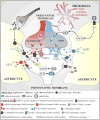Bidirectional neuro-glial signaling modalities in the hypothalamus: role in neurohumoral regulation
- PMID: 23375650
- PMCID: PMC3666096
- DOI: 10.1016/j.autneu.2012.12.009
Bidirectional neuro-glial signaling modalities in the hypothalamus: role in neurohumoral regulation
Abstract
Maintenance of bodily homeostasis requires concerted interactions between the neuroendocrine and the autonomic nervous systems, which generate adaptive neurohumoral outflows in response to a variety of sensory inputs. Moreover, an exacerbated neurohumoral activation is recognized to be a critical component in numerous disease conditions, including hypertension, heart failure, stress, and the metabolic syndrome. Thus, the study of neurohumoral regulation in the brain is of critical physiological and pathological relevance. Most of the work in the field over the last decades has been centered on elucidating neuronal mechanisms and pathways involved in neurohumoral control. More recently however, it has become increasingly clear that non-neuronal cell types, particularly astrocytes and microglial cells, actively participate in information processing in areas of the brain involved in neuroendocrine and autonomic control. Thus, in this work, we review recent advances in our understanding of neuro-glial interactions within the hypothalamic supraoptic and paraventricular nuclei, and their impact on neurohumoral integration in these nuclei. Major topics reviewed include anatomical and functional properties of the neuro-glial microenvironment, neuron-to-astrocyte signaling, gliotransmitters, and astrocyte regulation of signaling molecules in the extracellular space. We aimed in this review to highlight the importance of neuro-glial bidirectional interactions in information processing within major hypothalamic networks involved in neurohumoral integration.
Copyright © 2013 Elsevier B.V. All rights reserved.
Figures



Similar articles
-
The special relationship: glia-neuron interactions in the neuroendocrine hypothalamus.Nat Rev Endocrinol. 2018 Jan;14(1):25-44. doi: 10.1038/nrendo.2017.124. Epub 2017 Oct 27. Nat Rev Endocrinol. 2018. PMID: 29076504 Review.
-
Interconnections between the neuroendocrine hypothalamus and the central autonomic system. Geoffrey Harris Memorial Lecture, Kitakyushu, Japan, October 1998.Front Neuroendocrinol. 1999 Oct;20(4):270-95. doi: 10.1006/frne.1999.0186. Front Neuroendocrinol. 1999. PMID: 10569279 Review.
-
Central noradrenergic pathways for the integration of hypothalamic neuroendocrine and autonomic responses.Science. 1981 Nov 6;214(4521):685-7. doi: 10.1126/science.7292008. Science. 1981. PMID: 7292008
-
Neuronal-glial-endothelial interactions and cell plasticity in the postnatal hypothalamus: implications for the neuroendocrine control of reproduction.Psychoneuroendocrinology. 2007 Aug;32 Suppl 1:S46-51. doi: 10.1016/j.psyneuen.2007.03.018. Epub 2007 Jul 16. Psychoneuroendocrinology. 2007. PMID: 17629628 Review.
-
Forebrain nuclei involved in autonomic control.Prog Brain Res. 1991;87:253-68. doi: 10.1016/s0079-6123(08)63055-1. Prog Brain Res. 1991. PMID: 1866449 Review.
Cited by
-
Astrocytes Contribute to Angiotensin II Stimulation of Hypothalamic Neuronal Activity and Sympathetic Outflow.Hypertension. 2016 Dec;68(6):1483-1493. doi: 10.1161/HYPERTENSIONAHA.116.07747. Epub 2016 Oct 3. Hypertension. 2016. PMID: 27698069 Free PMC article.
-
Vasopressin Proves Es-sense-tial: Vasopressin and the Modulation of Sensory Processing in Mammals.Front Endocrinol (Lausanne). 2015 Feb 5;6:5. doi: 10.3389/fendo.2015.00005. eCollection 2015. Front Endocrinol (Lausanne). 2015. PMID: 25705203 Free PMC article. Review.
-
Preeclamptic placentae release factors that damage neurons: implications for foetal programming of disease.Neuronal Signal. 2018 Oct 12;2(4):NS20180139. doi: 10.1042/NS20180139. eCollection 2018 Dec. Neuronal Signal. 2018. PMID: 32714596 Free PMC article.
-
Brainstem astrocytes control homeostatic regulation of caloric intake.J Physiol. 2023 Feb;601(4):801-829. doi: 10.1113/JP283566. Epub 2023 Jan 25. J Physiol. 2023. PMID: 36696965 Free PMC article.
-
Multiple signalling modalities mediated by dendritic exocytosis of oxytocin and vasopressin.Philos Trans R Soc Lond B Biol Sci. 2015 Jul 5;370(1672):20140182. doi: 10.1098/rstb.2014.0182. Philos Trans R Soc Lond B Biol Sci. 2015. PMID: 26009761 Free PMC article. Review.
References
-
- Akine A, Montanaro M, Allen AM. Hypothalamic paraventricular nucleus inhibition decreases renal sympathetic nerve activity in hypertensive and normotensive rats. Auton Neurosci. 2003;108:17–21. - PubMed
-
- Allen AM. Inhibition of the hypothalamic paraventricular nucleus in spontaneously hypertensive rats dramatically reduces sympathetic vasomotor tone. Hypertension. 2002;39:275–280. - PubMed
-
- Araque A, Parpura V, Sanzgiri RP, Haydon PG. Tripartite synapses: glia, the unacknowledged partner. Trends Neurosci. 1999;22:208–215. - PubMed
Publication types
MeSH terms
Grants and funding
LinkOut - more resources
Full Text Sources
Other Literature Sources

